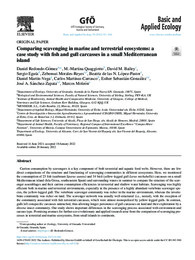Por favor, use este identificador para citar o enlazar este ítem:
https://hdl.handle.net/11000/33918Registro completo de metadatos
| Campo DC | Valor | Lengua/Idioma |
|---|---|---|
| dc.contributor.author | Redondo-Gómez, Daniel | - |
| dc.contributor.author | Quaggiotto, Maria-Martina | - |
| dc.contributor.author | Bailey, David | - |
| dc.contributor.author | Eguía, Sergio | - |
| dc.contributor.author | Morales-Reyes, Zebensui | - |
| dc.contributor.author | López-Pastor, Beatriz de las N. | - |
| dc.contributor.author | Martín-Vega, Daniel | - |
| dc.contributor.author | Martínez-Carrasco Pleite, Carlos | - |
| dc.contributor.author | Sebastián-González, Esther | - |
| dc.contributor.author | Sánchez Zapata, José Antonio | - |
| dc.contributor.author | Moleón, Marcos | - |
| dc.contributor.other | Departamentos de la UMH::Biología Aplicada | es_ES |
| dc.date.accessioned | 2024-11-19T09:46:46Z | - |
| dc.date.available | 2024-11-19T09:46:46Z | - |
| dc.date.created | 2022-01 | - |
| dc.identifier.citation | Basic and Applied Ecology, Volume 59, March 2022, Pages 92-104 | es_ES |
| dc.identifier.issn | 1439-1791 | - |
| dc.identifier.uri | https://hdl.handle.net/11000/33918 | - |
| dc.description.abstract | Carrion consumption by scavengers is a key component of both terrestrial and aquatic food webs. However, there are few direct comparisons of the structure and functioning of scavenging communities in different ecosystems. Here, we monitored the consumption of 23 fish (seabream Sparus aurata) and 34 bird (yellow-legged gull Larus michahellis) carcasses on a small Mediterranean island (Isla Grosa, southeastern Spain) and surrounding waters in summer to compare the structure of the scavenger assemblages and their carrion consumption efficiencies in terrestrial and shallow water habitats. Scavenging was highly efficient both in marine and terrestrial environments, especially in the presence of a highly abundant vertebrate scavenger species, the yellow-legged gull. The vertebrate scavenger community was richer in the marine environment, whereas the invertebrate community was richer on land. The scavenger network was usually well-structured (i.e., nested), with the exception of the community associated with fish terrestrial carcasses, which were almost monopolized by yellow-legged gulls. In contrast, gulls left conspecific carcasses untouched, thus allowing longer persistence of gull carcasses on land and their exploitation by a diverse insect community. Our study shows important differences in the scavenging process associated with environment and carcass type. Promising avenues for further eco-evolutionary and applied research arise from the comparison of scavenging processes in terrestrial and marine ecosystems, from small islands to continents. | es_ES |
| dc.format | application/pdf | es_ES |
| dc.format.extent | 13 | es_ES |
| dc.language.iso | eng | es_ES |
| dc.publisher | Elsevier | es_ES |
| dc.rights | info:eu-repo/semantics/openAccess | es_ES |
| dc.rights | Attribution-NonCommercial-NoDerivatives 4.0 Internacional | * |
| dc.rights.uri | http://creativecommons.org/licenses/by-nc-nd/4.0/ | * |
| dc.subject | Carcass type | es_ES |
| dc.subject | Carrion | es_ES |
| dc.subject | Community structure | es_ES |
| dc.subject | Facultative scavengers | es_ES |
| dc.subject | Scavenging efficiency | es_ES |
| dc.subject | Shallow waters | es_ES |
| dc.subject.other | CDU::5 - Ciencias puras y naturales::57 - Biología | es_ES |
| dc.title | Comparing scavenging in marine and terrestrial ecosystems: a case study with fish and gull carcasses in a small Mediterranean island | es_ES |
| dc.type | info:eu-repo/semantics/article | es_ES |
| dc.relation.publisherversion | https://doi.org/10.1016/j.baae.2022.01.006 | es_ES |

Ver/Abrir:
34.pdf
2,18 MB
Adobe PDF
Compartir:
 La licencia se describe como: Atribución-NonComercial-NoDerivada 4.0 Internacional.
La licencia se describe como: Atribución-NonComercial-NoDerivada 4.0 Internacional.
.png)